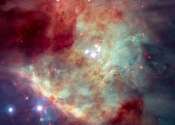NASA's Webb to study how massive stars' blasts of radiation influence their environments
In a nearby stellar nursery called the Orion Nebula, young, massive stars are blasting far-ultraviolet light at the cloud of dust and gas from which they were born. This intense flood of radiation is violently disrupting ...








